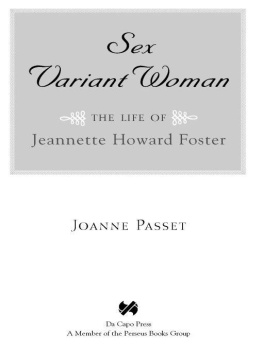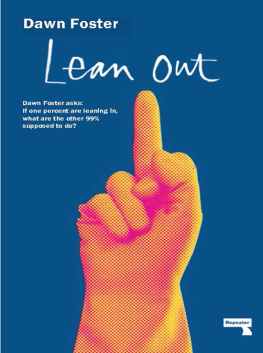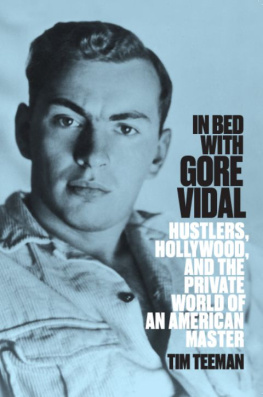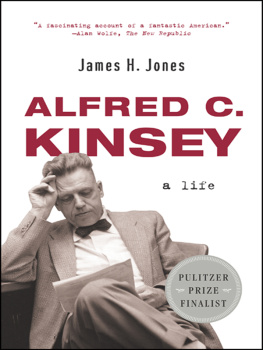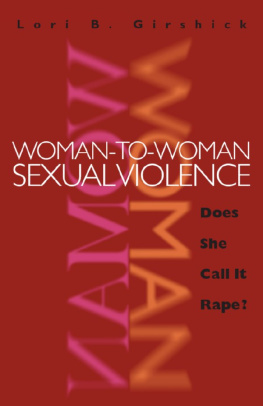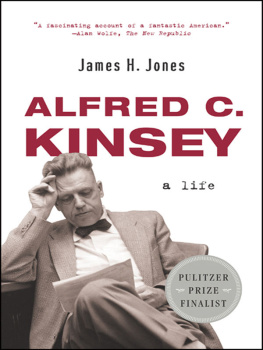Table of Contents
ALSO BY JOANNE PASSET:
Aspirations and Mentoring in an Academic Environment
(with Mary Niles Maack)
Cultural Crusaders: Women Librarians and the American West, 1900-1917
Sex Radicals and the Quest for Womens Equality
For those who treasured Fosters work.
FOREWORD
Im twenty-two years old and the year is 1962. Ive just been admitted to UCLA as a graduate student in English. McCarthyism isnt over, and before Im permitted to become a teaching assistant in the English Departmenta glorious honorI have to sign a loyalty oath that promises that Im not subversive. I sign the oath without a qualm because I know Ill be too busy studying English literature and teaching English 1A to think about overturning the government. Yet I am indeed subversivemy sexuality is certainly subversive. And Im sure that if it should come to be known by the authorities, whoever they are, Ill be booted out of UCLAdenied a place on that enchanting campus, with its grand old buildings and stellar faculty and its promise that if I behave myself Ill be credentialed into a career of scholarship for which I yearn. So I watch where I step and look over my shoulder a lot. As far as I know, Im the only homosexual at UCLA, and I have to make sure that no one suspects.
But something very confusing happens to me during my first few weeks on campus. I get seduced. By a book. Ive made it a habit already in between my classes to go study in the English Reading Room, a small, comfortable retreat for graduate students and faculty. The English Reading Room has a pretty good little library that includes most of the books that are assigned in the graduate classes. Today Im after an E. M. Forster book Passage to India or Howards End, perhapscertainly not Maurice, a novel about Forsters own homosexual desires, which he wrote in 1913, in between those other two novels, but of which Id never heard, because it was not to be published until 1971, a year after he was safely dead, and almost a decade after my story. Clearly my Brit Lit prof had never heard of Maurice either, or if he had, he wasnt telling. Just as he wasnt telling other things that would have interested me passionately about the writers we read for his course, things such as the fact that Forster was a homosexual, and that most of his Bloomsbury friendsLytton Strachey, Virginia Woolf, and a slew of othersshared his gay proclivities. Nor were the biographies I read in 1962 telling. As far as I knew, the Bloomsbury writers were eccentric bachelors or proper married ladies, quite without frightening, dark secrets such as my own. I was virtually alone in my scary subversion, and the fact that no one ever said the word homosexual at UCLAunless perhaps you were in an abnormal psych classwas proof of my aloneness.
But I digress. So Im in the stacks of the English Reading Room about to be seduced. Im looking for a novel by E. M. Forster, and its not there. Someone else from my class must already have taken it off the shelf. But in the spot where the book is supposed to be sitting is another book, not by Forster, but by Foster. Jeannette Foster. With the title Sex Variant Women in Literature. Sex Variant. Could it be? Surely not. Not in the UCLA English Reading Room. I look to my right and to my left to make sure no one is coming, and I hurriedly take it from the shelfthat book, and then E. M. Forsters Where Angels Fear to Tread , to serve as a cover, so that if someone should happen by theyd see me with two books in my hand, but theyd only be able to read the title of the Forster book. Is Sex Variant Women really a euphemism for what I think it is?
It is! And that spectacular revelation knocks the breath out of me. I can see from a cursory look that Sex Variant Women in Literature is a remarkable book-length bibliography in which the author presents 2500 years worth of writings about love and sex between women, literature especially from America, England, France, and Germany, literature especially from the seventeenth and eighteenth and nineteenth centuries, as well as the first half of the twentieth century. All of it about female same-sex relationships! Standing there in the stacks, I devour the opening section, even forgetting to look over my shoulder to see if Im being observed. I read for twenty minutes or half an hour, and no one comes by to frighten me away. But I mustnt press my luck. I place the book back in its slot, vowing to visit it again as soon as I can, praying Ill have no rival for my devoted attention to it. What will I do if I come back to find that someone has snatched it away?
I think about the book constantly when I cant be holding it in my hands and losing myself in the guilty pleasures of it there in the dim lit Reading Room stacks.
It had been published in 1956. Id never heard of the publisher, Vantage Press. A so-called vanity press, I was sure. But it did not surprise me that no real publisher would take a risk on so subversive a book. Paperback publishers were still bringing out pulps about Odd Girls or Twilight Lovers, in which young women like me invariably ended badlybut who in the 1950s and even in 1962 would want to read this erudite bibliographic study of literature that dealt with a subject no respectable person ever seemed to want to talk about?
Who except me? My secret love sat waiting for me always, revealing beauties and wonders whenever I could pay a visit. It took me the whole semester to finish Sex Variant Women in Literature , ten or so pages at a time, standing in the stacks, never daring to take the book out to a soft chair in the Reading Room, where I would be so much more comfortable.
Despite my romance with Fosters book, I couldnt imagine in those days how profoundly it would affect my life. I went on to finish graduate school with a Ph.D., never once in my years at UCLA hearing a word such as homosexual from my professors, though we read Walt Whitman and Emily Dickinson and W. H. Auden and Stephen Spender and Carson McCullers and James Baldwin and... the list is endless. Though I would have loved to have done my dissertation on one of the women authors about whom Jeannette Foster wrote in Sex Variant Women in Literature , it was still the mid-1960s, and I wasnt crazy. With my advisors blessings, I wrote my dissertation on the stirring topic of B. L. Farjeon and the Popular Victorian Novel. My passion for Fosters book remained my secret.
Until the glorious revolutions of the late 1960s and the 1970s. In 1976 a Women in Print conference brought together lesbians and feminists who were interested in all aspects of publishing and selling literature by and about lesbians. Soon womens bookstores were proliferating all over the countryliterally hundreds of themand Jeannette Foster, whose Sex Variant Women in Literature had long been out of print, came back into print with two other booksa collection of her poems and a translation of a Renee Vivien novel.
By then I no longer felt that I had to read her work standing in dimly lit library stacks. I found a used copy of Sex Variant Women in Literature in a womens bookstore, and I reread it, devouring it once again, so cognizant this time of the changes for the better that had taken place since Id first found Fosters book almost fifteen years earlier. It was the inspiration of that book that made me begin in 1976 the study that would eventually be published in 1981 as Surpassing the Love of Men: Romantic Friendship and Love between Women from the Renaissance to the Present . As I say on the acknowledgement page of that book, Fosters work was indispensable to my own, and it was my fondest wish that what I wrote would be as helpful to future scholars as Sex Variant Women in Literature was to me. That was an extremely ambitious wish because I think that no serious scholar of lesbian literature to this day can do without Fosters wonderful book.

